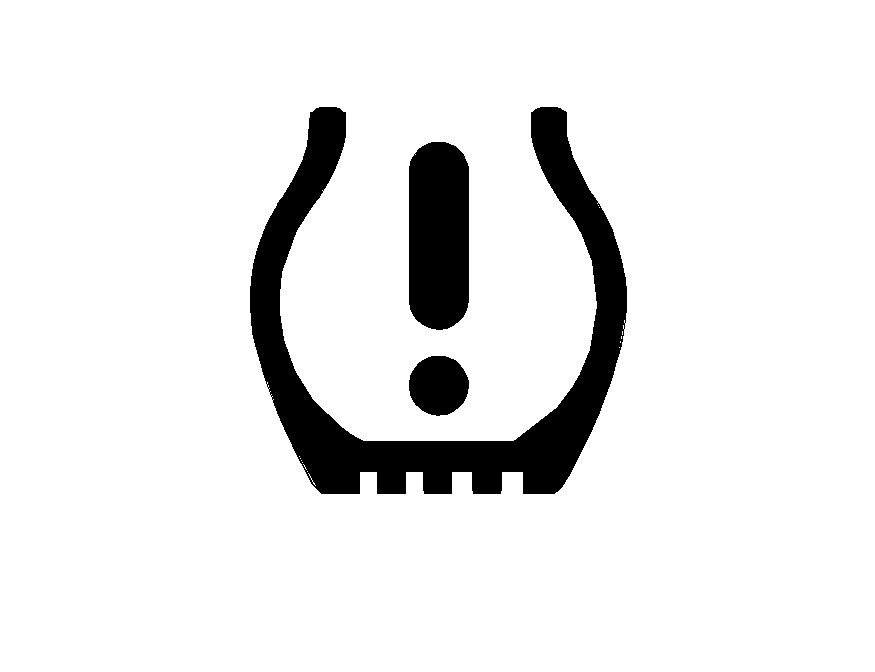Your vehicle may have this feature. The Tire Pressure Monitor (TPM) system uses radio and sensor technology to check tire pressure levels. If your vehicle has this feature, sensors are mounted on each tire and wheel assembly, except for the compact spare tire and wheel. Tire pressure readings are sent to a receiver located in the vehicle.
When a low tire pressure condition is detected, the TPM system will display the Check Tire Pressure warning message on the Driver Information Center (DIC) and, at the same time, illuminate the low tire pressure warning symbol, on the instrument panel cluster. For additional information and details about the DIC operation and displays see System Controls and DIC Warnings and Messages .

When the tire pressure monitoring system warning light is lit, one or more of your tires is significantly under-inflated.
You should stop and check your tires as soon as possible, and inflate them to the proper pressure as indicated on the vehicle's tire information placard.
Driving on a significantly under-inflated tire causes the tire to overheat and can lead to tire failure. Under-inflation also reduces fuel efficiency and tire tread life, and may affect the vehicle's handling and stopping ability. Each tire, including the spare, should be checked monthly when cold and set to the recommended inflation pressure as specified in the vehicle placard and owner's manual.
The Certification/Tire label or the Tire and Loading Information Label (your vehicle's tire information placard) shows the size of your vehicle's original tires and the recommended cold inflation pressure for your vehicle's tire. See Inflation - Tire Pressure . For the location of the tire and loading information label, see Loading the Vehicle .
Your vehicle's TPM system can alert you about a low tire pressure condition but it does not replace normal tire maintenance. See Tire Inspection and Rotation and Tires .
Notice: Do not use a tire sealant if your vehicle has Tire Pressure Monitors. The liquid sealant can damage the tire pressure monitor sensors.
TPM Sensor Identification Codes
Each TPM sensor has a unique identification code. Any time you replace one or more of the TPM sensors, the identification codes will need to be matched to the new tire/wheel position. Each tire/wheel position is matched, to a sensor, by increasing or decreasing the tire's air pressure. The sensors are matched, to the tire/wheel positions, in the following order: left front (LF), right front (RF), right rear (RR), and left rear (LR).
You will have one minute to match the first tire/wheel position, and five minutes overall, to match all four tire/wheel positions. If it takes longer than one minute, to match the first tire and wheel, or more than five minutes to match all four tire/wheel positions the matching process stops and you will need to start over.
The TPM matching process is outlined below:
- Set the Parking brake.
- Turn the ignition switch to ON with the engine off.
- Using the Remote Keyless Entry (RKE) transmitter, lock and unlock the vehicle's doors.
- Press the lock and unlock buttons, at the same time, on the RKE transmitter. A single horn chirp will sound, indicating that the TPM system is ready, and the sensor matching process can begin.
- Start with the left (driver's side) front tire.
- Remove the valve cap from the valve stem. Activate the TPM sensor by increasing or decreasing the tire's air pressure for five seconds, or until a horn chirp sounds. The horn chirp, which may take up to 30 seconds, confirms that the sensor identification code has been matched to this tire position. To decrease the tire's air-pressure use the pointy end of the valve cap, a pencil-style air pressure gage or a key.
- Proceed to the right (passenger's side) front tire, and repeat the procedure in Step 6.
- Proceed to the right (passenger's side) rear tire, and repeat the procedure in Step 6.
- Proceed to the left (driver's side) rear tire, and repeat the procedure in Step 6.
- After hearing the confirming double horn chirp, for the left rear tire, exit the matching process by turning the ignition switch to OFF.
- Set all four tires to the recommended air pressure level as indicated on the tire and loading information label.
- Put the valve caps back on the valve stems.
The spare tire does not have a TPM sensor. If you replace one of the road tires with the spare, the Service Tire Monitor message will be displayed on the DIC screen. This message should go off once you re-install the road tire containing the TPM sensor. The Service Tire Monitor message is also displayed when the TPM system is malfunctioning. One or more missing or inoperable TPM sensors will cause the service tire monitor message to be displayed. See your dealer for service.
This device complies with Part 15 of the FCC Rules. Operation is subject to the following two conditions:
- this device may not cause interference, and
- this device must accept any interference received, including interference that may cause undesired operation.
This device complies with RSS-210 of Industry Canada. Operation is subject to the following two conditions:
- this device may not cause interference, and
- this device must accept any interference received, including interference that may cause undesired operation of the device.
Changes or modifications to this system by other than an authorized service facility could void authorization to use this equipment.
